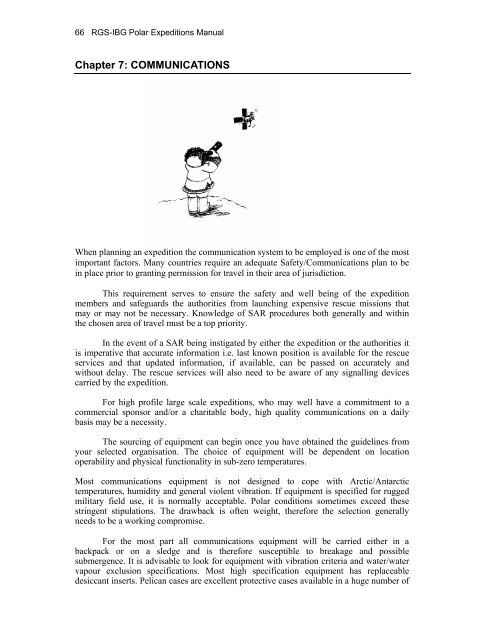Edited by Rachel Duncan 4th Edition ISBN 0-907649-91-2 London ...
Edited by Rachel Duncan 4th Edition ISBN 0-907649-91-2 London ...
Edited by Rachel Duncan 4th Edition ISBN 0-907649-91-2 London ...
Create successful ePaper yourself
Turn your PDF publications into a flip-book with our unique Google optimized e-Paper software.
66 RGS-IBG Polar Expeditions Manual<br />
Chapter 7: COMMUNICATIONS<br />
When planning an expedition the communication system to be employed is one of the most<br />
important factors. Many countries require an adequate Safety/Communications plan to be<br />
in place prior to granting permission for travel in their area of jurisdiction.<br />
This requirement serves to ensure the safety and well being of the expedition<br />
members and safeguards the authorities from launching expensive rescue missions that<br />
may or may not be necessary. Knowledge of SAR procedures both generally and within<br />
the chosen area of travel must be a top priority.<br />
In the event of a SAR being instigated <strong>by</strong> either the expedition or the authorities it<br />
is imperative that accurate information i.e. last known position is available for the rescue<br />
services and that updated information, if available, can be passed on accurately and<br />
without delay. The rescue services will also need to be aware of any signalling devices<br />
carried <strong>by</strong> the expedition.<br />
For high profile large scale expeditions, who may well have a commitment to a<br />
commercial sponsor and/or a charitable body, high quality communications on a daily<br />
basis may be a necessity.<br />
The sourcing of equipment can begin once you have obtained the guidelines from<br />
your selected organisation. The choice of equipment will be dependent on location<br />
operability and physical functionality in sub-zero temperatures.<br />
Most communications equipment is not designed to cope with Arctic/Antarctic<br />
temperatures, humidity and general violent vibration. If equipment is specified for rugged<br />
military field use, it is normally acceptable. Polar conditions sometimes exceed these<br />
stringent stipulations. The drawback is often weight, therefore the selection generally<br />
needs to be a working compromise.<br />
For the most part all communications equipment will be carried either in a<br />
backpack or on a sledge and is therefore susceptible to breakage and possible<br />
submergence. It is advisable to look for equipment with vibration criteria and water/water<br />
vapour exclusion specifications. Most high specification equipment has replaceable<br />
desiccant inserts. Pelican cases are excellent protective cases available in a huge number of

















